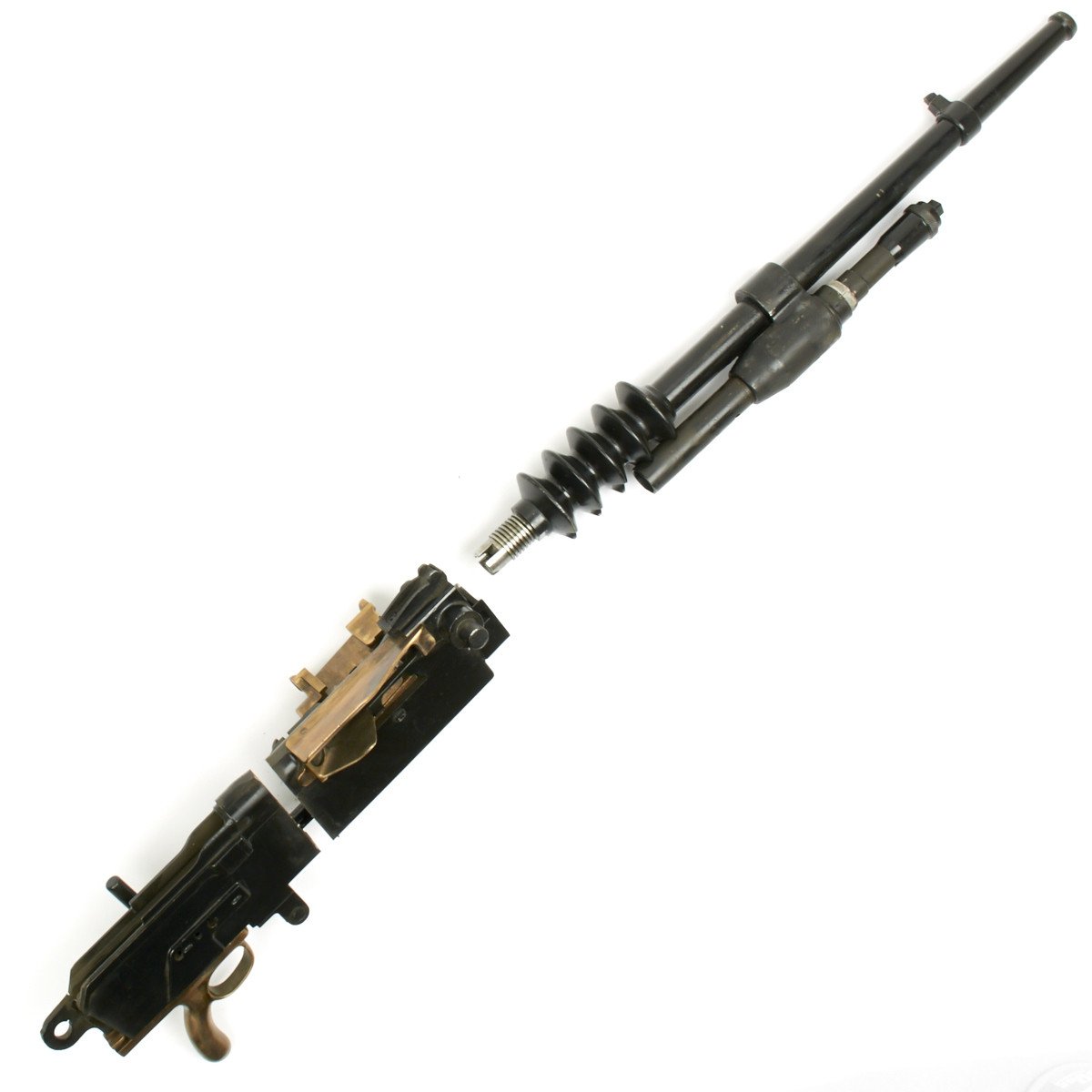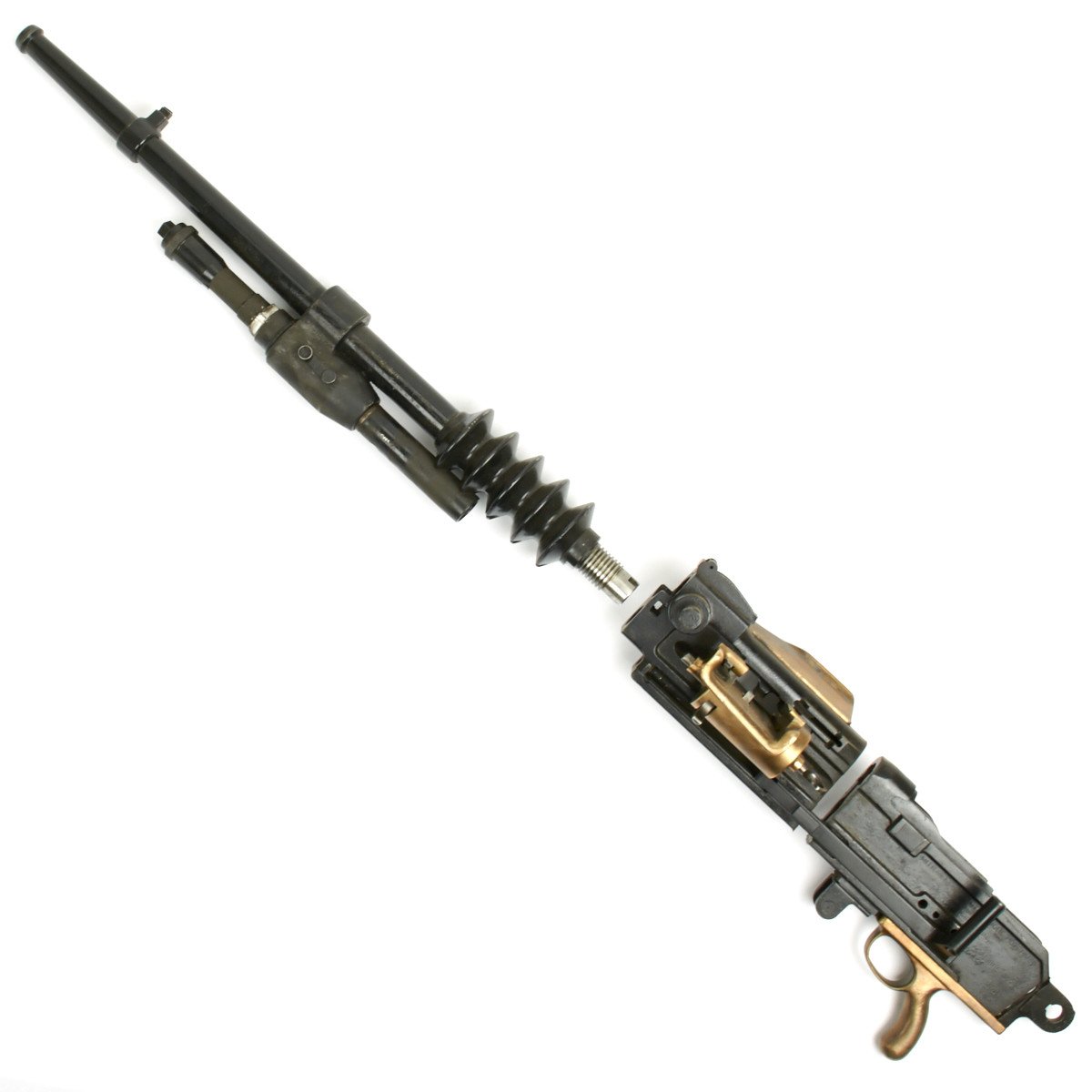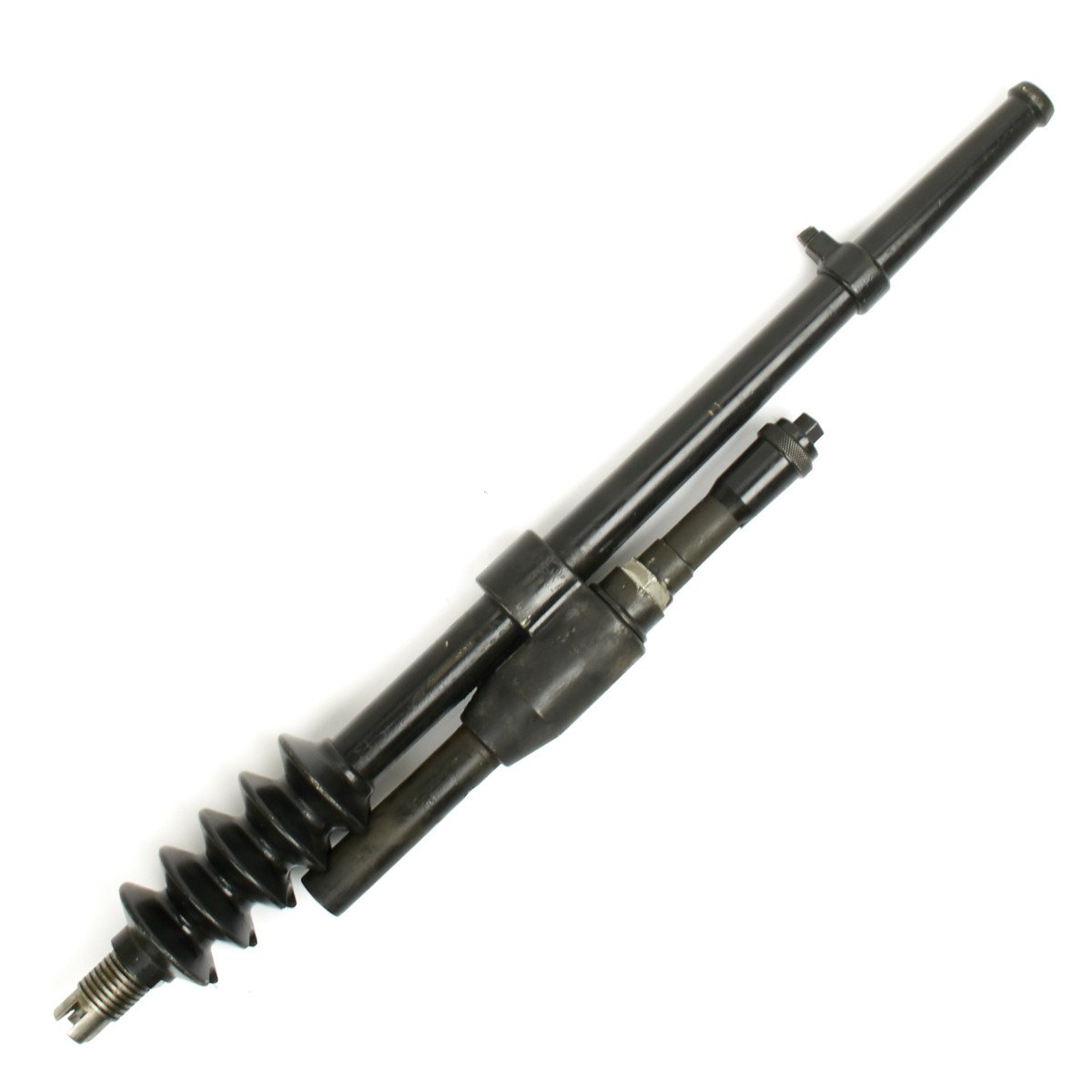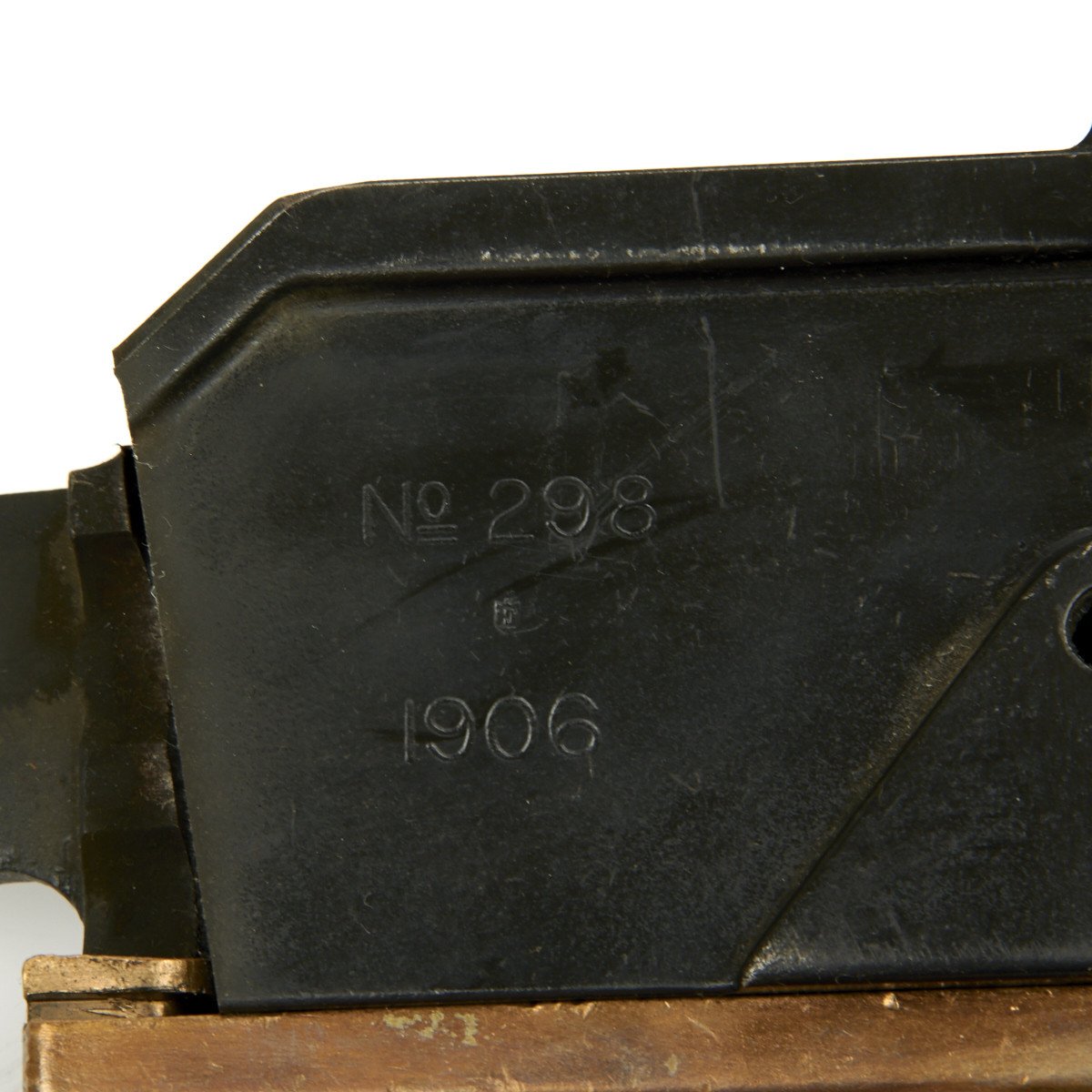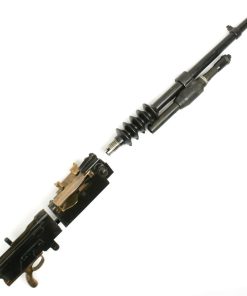Original French WWI Hotchkiss MLE 1900 Machine Gun Partial Parts Set – Dated 1906 Original Items
$ 995,00 $ 248,75
Original Item: Only One Available. The Mle 1914 was the last version of a series of nearly identical Hotchkiss designs : the Mle 1897, Mle 1900 and the Mle 1908.
This is a very nice condition partial parts set. Featuring, brass pistol grip and other parts, heavy barrel, matched serial numbers and best of all a BATF approved original de-militarized receiver nicely marked:
MITRAILLEUS AUTOMATIQUE HOTCHKISS
CALIBRE 8 m/m
Mo 298 FEU SURETE
1906M/CENTER>
The Mle 1914 Hotchkiss machine gun chambered for the 8mm Lebel cartridge became the standard machine gun of the French Army during World War I. It was manufactured by the French arms company Hotchkiss et Cie, which had been established in the 1860s by American industrialist Benjamin B. Hotchkiss. The gas-actuated Hotchkiss system was first formulated in 1895 by Odkolek von Ujezda and improved into its final form by Hotchkiss armament engineers Laurence Benét and Henri Mercié.
The Mle 1914 was the last version of a series of nearly identical Hotchkiss designs : the Mle 1897, Mle 1900 and the Mle 1908. The Hotchkiss Mle 1914 became the French infantry standard in late 1917, replacing the unreliable St. Étienne Mle 1907. The American Expeditionary Forces (AEF) in France also purchased 7,000 Mle 1914 Hotchkiss machine guns in 8mm Lebel, and used them extensively at the front in 1917 and 1918. Hotchkiss heavy machine guns, some being of earlier types, were also used in combat by Japan, Chile, Mexico, Spain, Belgium, Brazil and Poland.
The Hotchkiss machine gun, a sturdy and reliable weapon, remained in active service with the French army until the early 1940s. By the end of 1918, 47,000 Hotchkiss machine guns had already been delivered to the French army alone. If one includes all the international sales, the grand total of all Hotchkiss machine guns sold by the manufacturer in various calibers is well in excess of 100,000 units.
History and Design:
The Hotchkiss was based on a design by Captain Baron Adolf Odkolek von Ujezda of Vienna. The patents had been purchased in 1893 by the firm of Benjamin Hotchkiss, based in Saint-Denis, near Paris. Benjamin Hotchkiss was no longer alive at the time of the purchase, but the Odkolek design was further developed and greatly improved under the direction of American-born Laurence Vincent Benét (18631948) with the assistance of Henri Albert Mercié. After trials that began in 1895, development issues were resolved leading to the initial purchase of the Hotchkiss gun by the French Military in 1897. In 1898 an export model was also offered for international sales by Hotchkiss. With some useful changes, such as the addition of five cooling radiator rings on the barrel, the same basic design led to the M1900, and later to the M1914 (with minor improvements that were added since 1908). In the meantime adoption of the St. Étienne Mle 1907 (a French government arsenal product ) to equip the infantry went through in 1908. Nevertheless, Hotchkiss machine guns were also purchased by the French military for use in overseas colonies and by mountain troops in the Alps. By the 1916, during World War I, French line infantry, still equipped with the unsatisfactory Saint-Etienne, convinced General Petain that it needed the more reliable Hotchkiss. It got its wish and French infantry divisions became progressively outfitted with the Hotchkiss gun in late 1917 and early 1918.
The Hotchkiss machine gun was gas actuated and air-cooled, in contrast to the Maxim gun which was recoil operated and water-cooled. The Hotchkiss machine gun barrel features five large annular rings which materially assisted natural cooling and retarded overheating. The gas cylinder under the barrel features a regulator piston which can be adjusted to the normal rate of fire of 450 rounds per minute. The Hotchkiss machine gun itself (excluding the tripod) has only 32 parts ( US War Department Handbook of the Hotchkiss Machine Gun, Model of 1914 ) including four coil springs and no screws or pins whatsoever. All parts of the gun are constructed in such a manner that it is impossible to assemble them improperly. The Hotchkiss fired from an open bolt, like almost all modern machine guns in order to avoid “cook-offs” . Although the Hotchkiss machine gun was easy to feed continuously with a three-man team, each individual strip held only 24 rounds of 8mm Lebel ammunition. Each empty feed strip was ejected automatically after its last round had been fired, leaving the bolt open in the rear position. Then introducing a new loaded strip into the gun triggered the release forward of the bolt and firing resumed. The Hotchkiss strips performed well with a three-man crew, but their capacity was too small for a single gunner firing from the inside of a tank. This led to the adoption of a 250-round articulated metal belt in 1917. It was widely used in all French tanks of the period and in some military airplanes .
Beginning in 1900, two basic tripod types were used prior to World War I, when the final and most effective third Hotchkiss tripod model (the Mle 1916) became adopted and widely distributed. A tripod that could be used for both the Hotchkiss and the St. Etienne machine guns was issued in 1915: the so-called “Omnibus Tripod”. The French Hotchkiss had a rate of fire of approximately 450 rounds per minute of 8 mm Lebel ammunition, and a maximum effective range of 3,800 m (4,150 yd) with the “Balle D” bullet. Fire for effect was usually in successive bursts of 8 to 10 rounds. The gun could sustain continuous firing of about 120 aimed shots per minute almost indefinitely ( US War Department Handbook,1917 ) except for occasional barrel changes (during continuous fire, approximately every 1,000 rounds) which were quick and easy to perform with a special wrench. The barrel could attain a temperature of about 400 °C, at which temperature it would be dark red in color. At this point the barrel dissipated heat as fast as it was generated. This only occurred after long continuous firing in a combat emergency situation. The most common complaint about the Hotchkiss was its weight: the gun and tripod weighed a total of 110 pounds. There were also complaints concerning the tripods, particularly the “Omnibus” tripods, which were perceived as too high above ground and too heavy.
The principal user of the Mle 1914 Hotchkiss machine gun was French infantry during World War I and in 1939-40. The Hotchkiss company delivered 47,000 Mle 1914 machine guns to the French Army between 1914 and the end of 1918. Several hundred were in the 11mm Gras caliber for anti balloons use since it was the smallest caliber to be able to receive an incendiary bullet but all the others were in 8mm Lebel. The second-largest user of the Hotchkiss gun was the American Expeditionary Forces in France between 1917 and 1918. The U.S. purchased and used in combat 7,000 Mle 1914 Hotchkiss machine guns, also in 8mm Lebel.
Fast Shipping with Professional Packaging
Thanks to our longstanding association with UPS FedEx DHL, and other major international carriers, we are able to provide a range of shipping options. Our warehouse staff is expertly trained and will wrap your products according to our exact and precise specifications. Prior to shipping, your goods will be thoroughly examined and securely secured. We ship to thousands clients each day across multiple countries. This shows how we're dedicated to be the largest retailer on the internet. Warehouses and distribution centres can be located throughout Europe as well as the USA.
Note: Orders with more than one item will be assigned a processing date depending on the item.
Before shipping before shipping, we'll conduct a thorough inspection of the items you have ordered. Today, the majority of orders will be delivered within 48 hours. The delivery time will be between 3-7 days.
Returns
The stock is dynamic and we cannot completely manage it because multiple stakeholders are involved, including our factory and warehouse. So the actual stock may alter at any time. It's possible that you may not receive your order once the order has been made.
Our policy is valid for a period of 30 days. If you don't receive the product within 30 days, we are not able to issue a refund or an exchange.
You can only return an item if it is unused and in the same state as the day you received it. You must have the item in its original packaging.
Related products
Uncategorized
Uncategorized
Uncategorized
Uncategorized
Uncategorized
Uncategorized
Uncategorized
Uncategorized
Uncategorized
Uncategorized
Armored Burgonet Helmet & Polearm from Scottish Castle Leith Hall Circa 1700 Original Items
Uncategorized
Uncategorized
Uncategorized
Uncategorized
Uncategorized
Angolan Rebel 1970s era 60mm Inert Display Mortar from Angolan Civil War Original Items
Uncategorized
Uncategorized
Uncategorized
Uncategorized
Uncategorized
Armoured Fighting Vehicles of the World: AFVs of World War One (Hardcover Book) New Made Items
